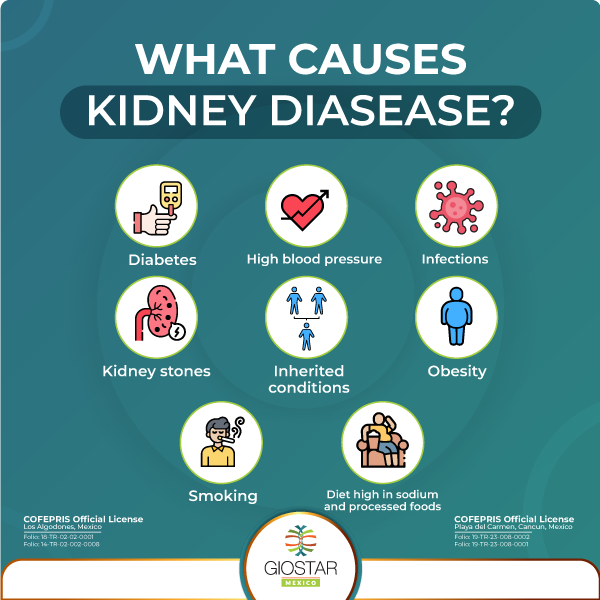What is Kidney Disease?

The kidneys are essential organs that filter waste and excess fluids from the body, maintaining a healthy balance of chemicals and fluids. Kidney disease is a condition that occurs when the kidneys are damaged and can no longer function properly. This can lead to a buildup of waste and toxins in the body, which can cause a range of health problems. In this blog, we will explore what kidney disease is, what causes it, its symptoms, and available treatments.
There are many factors that can cause kidney disease, including diabetes, high blood pressure, and family history. If left untreated, kidney disease can progress to more severe stages, such as chronic kidney disease and end-stage renal disease. In this blog, we will discuss the various causes of kidney disease and how to recognize the symptoms. We will also explore available treatment options, including stem cell therapy.
Kidney disease
Kidney disease, also known as renal disease, refers to a condition where the kidneys are damaged and can no longer function properly. This can lead to a buildup of waste and toxins in the body, causing a range of health problems. There are several factors that can contribute to kidney disease, including diabetes, high blood pressure, and family history. Other factors that can increase the risk of developing kidney disease include smoking, obesity, and age.
Kidney disease can be classified into different types, depending on the cause and severity of the condition. Chronic kidney disease (CKD) is a long-term condition that progresses slowly over time, often without symptoms until the later stages. Acute kidney injury (AKI), also known as acute renal failure, is a sudden and often reversible loss of kidney function that can be caused by infections, medications, or other medical conditions. Polycystic kidney disease (PKD) is a genetic disorder where cysts form in the kidneys, causing them to enlarge and lose function over time. It’s essential to recognize the symptoms of kidney disease early on, as early detection and treatment can slow the progression of the disease and help prevent complications.
What causes kidney disease
Kidney disease can have various causes, some of which are preventable, and others that are not. The leading causes of kidney disease include diabetes and high blood pressure. These conditions can damage the blood vessels in the kidneys, causing them to lose function over time. Other causes of kidney disease include infections, medications, kidney stones, and inherited conditions, such as polycystic kidney disease.
Certain lifestyle factors can also increase the risk of developing kidney disease, such as smoking, obesity, and a diet high in sodium and processed foods. Age and family history can also play a role in the development of kidney disease. It’s essential to understand the risk factors for kidney disease and take steps to reduce them where possible. Regular check-ups with a healthcare provider can help detect kidney disease early on, allowing for appropriate treatment to be administered.

What are symptoms of kidney disease
The symptoms of kidney disease can vary depending on the stage of the disease. In the early stages, there may be no symptoms at all, and kidney disease may only be detected through routine blood and urine tests. However, as the disease progresses, symptoms can include:

It’s important to note that these symptoms can also be caused by other conditions, so it’s important to seek medical attention for an accurate diagnosis and appropriate treatment. Early detection and management of kidney disease can help slow the progression of the disease and improve overall outcomes.
Kidney disease treatment
Kidney disease can be treated through various methods depending on the severity of the condition. The initial treatment options may include medications to control blood pressure and reduce the risk of further damage to the kidneys. In more advanced stages of kidney disease, dialysis may be required to filter the blood and remove waste products that the kidneys are no longer able to eliminate. For some individuals with end-stage kidney disease, a kidney transplant may be an option to replace the damaged kidneys with a healthy one from a donor.
In recent years, stem cell therapy has emerged as a promising treatment option for kidney disease. This therapy involves the use of stem cells to regenerate and repair damaged kidney tissue. Studies have shown that stem cell therapy can improve kidney function, reduce inflammation, and lower the risk of kidney failure in individuals with chronic kidney disease. In addition, stem cells can be used to reduce the risk of rejection in individuals undergoing kidney transplant.
Stem cell therapy for kidney disease
With stem cell therapy for Chronic Kidney Disease, the application of mesenchymal stem cells focuses on stopping the progression of CKD by boosting the immune system and helping repair the damaged tissue, renal structure, and body functions lost by the condition.
In addition, our protocol can also help decrease inflammation and symptoms; help to prevent other conditions caused by CKD, and be beneficial to address autoimmune diseases as well.
How much does stem cell therapy cost?
The cost of Stem Cell Therapy needs to be determined by our expert medical team, as prices depend on the specific condition and personalized medical recommendations. Our dedicated team of medical professionals carefully evaluates each patient’s unique health situation to recommend the most effective therapy. Stem Cell Therapy includes the following:
- Laboratory protocol by Dr. Anand (activation of the stem cells to direct them towards the affected tissue or organ)
- 1 – 3 stem cell vials (35 – 105 million stem cells)
- 1 – 10 billion exosomes (volume depends on the doctor’s personal evaluation of each patient)
- Oxygen Therapy
- Body preparation
- Medical Consultation
- Dietitian Follow-up post-therapy
- Transportation hotel-clinic in local shuttle
- Lodging (available in our Clinic in Algodones) at Hotel Hacienda or Hotel Cielito Lindo
- Preferential prices for future reinforcements/applications
References
Mayo Clinic. (2021). Chronic Kidney Disease. Retrieved from https://www.mayoclinic.org/diseases-conditions/chronic-kidney-disease/symptoms-causes/syc-20354521
Levey, A. S., Coresh, J., & Balk, E. (2003). National Kidney Foundation practice guidelines for chronic kidney disease: evaluation, classification, and stratification. Annals of internal medicine, 139(2), 137-147. doi: 10.7326/0003-4819-139-2-200307150-00013
Jain, N., & Reilly, R. F. (2010). Effects of dietary interventions on incidence and progression of CKD. Nature Reviews Nephrology, 6(11), 566-577. doi: 10.1038/nrneph.2010.103
Thomas, R., & Kanso, A. (2015). Sudden cardiac death in hemodialysis patients: a comprehensive care approach to reduce risk. Blood Purification, 39(1-3), 158-165. doi: 10.1159/000368789
Li, L., Astor, B. C., Lewis, J., Hu, B., Appel, L. J., Lipkowitz, M. S., … & Perrone, R. D. (2011). Longitudinal progression trajectory of GFR among patients with CKD. American Journal of Kidney Diseases, 59(4), 504-512. doi: 10.1053/j.ajkd.2011.01.007
Li, X., Chen, W., & Fan, X. (2018). Effects and Mechanisms of Mesenchymal Stem Cell Therapy for Liver Fibrosis. International Journal of Stem Cells, 11(1), 30-38. doi: 10.15283/ijsc17033
Lindoso, R. S., & Verdoorn, K. S. (2019). Stem Cell Therapies for Chronic Kidney Disease: A Review of Clinical Trials. Stem Cells Translational Medicine, 8(2), 138-148. doi: 10.1002/sctm.18-0055
Macedo, C., Hoyer, K. K., & Davis, C. L. (2019). Stem Cell Therapy in Kidney Transplantation: Current Status and Future Directions. American Journal of Kidney Diseases, 73(2), 324-331. doi: 10.1053/j.ajkd.2018.07.011


